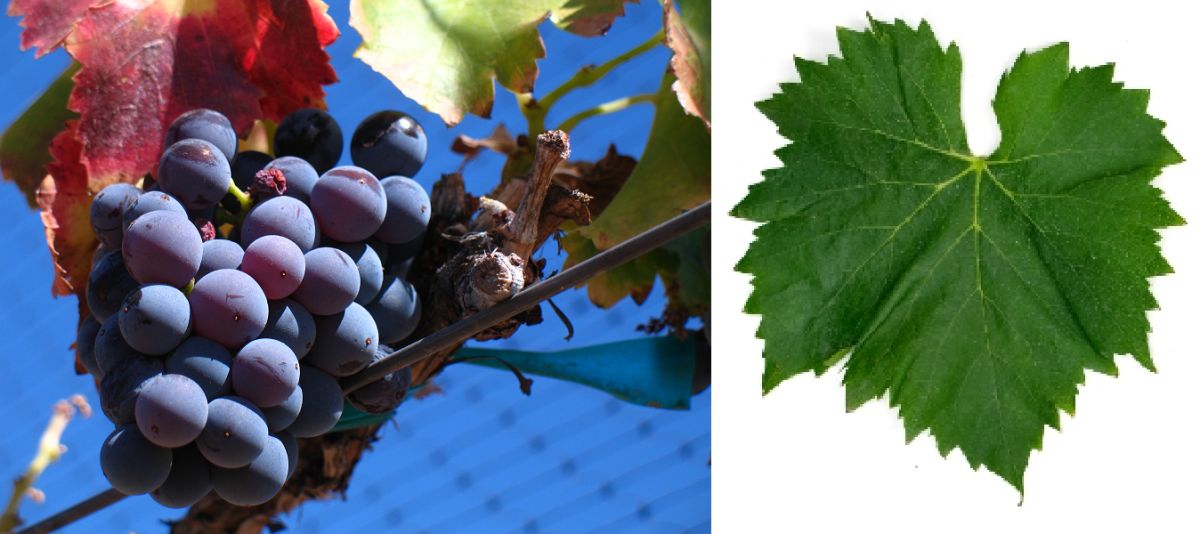The red grape variety originates from Spain and belongs to the Garnacha group of varieties. There are more than a hundred synonyms that indicate great age and worldwide distribution. The most important ones grouped alphabetically by country are (other main names in bold). Blauer Alicant (Germany); Alicante de Pays, Alicante di Spagna, Alicante Grenache, Alicante Noir, Bois Jaune, Carignan Rouge, Espagnin Noir, Gamay Perugino, Granache, Grenache, Grenache Noir, Navarre de la Dordogne, Redonda, Rool Grenache, Roussillon, Sans Pareil (France); Aleante, Aleante di Rivalto, Aleante Poggiarelli, Cannoao, Cannonaddu, Cannonadu, Cannonadu Nieddu, Cannonao, Cannonatu, Cannonau, Cannonau di Villasor, Cannonau Nero, Cannonau Selvaggio, Cannono, Canonao, Canonazo, Granaxia, Ranaccio, Tai Rosso, Tintoria, Tocai Rosso, Vrannaxia, Vernaccia di Serrapetrona, Vernaccia Nera (Italy); Grenache Crni (Croatia); Abundante, Abundante de Reguengos, Tinta (Portugal); Alicante, Aragones, Aragonesa, Aragones Macho, Bernacha Negra, Garnaccia, Garnacha, Garnacha Negra, Garnacha Pais, Garnacho Negro, Garnatxa, Garnatxa Negra, Garnatxa Pais, Garnatxa Tinta, Garnaxa, Gironet, Granaccia, Granacha, Granacha Fina, Granache, Granaxia, Granaxo, Guarnaccia, Lladoner Aragonase, Lladoner Negre/Negro, Licante, Navarra, Tinta, Tinta Menuda, Tintella, Tintilla, Tinto Basto, Tinto de Navalcarnero, Tintore di Spagna, Vidueño Negro (Spain); Black Spanish, Black Valentina (USA).
It must not be confused with the varieties Alicante Henri Bouschet (Garnacha Tintorera), Morrastel Bouschet (Garnacho), Plant Droit (Garnacha Francesa), Tempranillo (Garnacho Foño, Grenache de Logrono), Tinto de Navalcarnero or Vidadillo de Almonacid (Garnacha Basta), despite seemingly suggestive synonyms or morphological similarities. For Garnacha Tinta, no parent-offspring relationships have yet been proven. Direct descendants of Garnacha Tinta through presumably natural crossings are the varieties Doronadu, Olho de Cocco and Rosonadu.

The late-maturing vine is susceptible to downy mildew, black spot disease and botrytis, but resistant to wood diseases such as esca and eutypiosis and thus long-lived. Also advantageous is its resistance to drought in hot, dry areas, where it is often grown in bush form. This makes it predestined for climate change, so to speak. The variety produces rather low-coloured and low-acid, soft but high-alcohol red wines. These are mainly used for rosé wines or as blending partners with the tannic varieties Tempranillo in Spain, as well as Mourvèdre (Monastrell) and Syrah in France. The variety is considered a real mass producer. With correspondingly low yields, however, the variety can produce red wines full of character with storage potential. It belongs to the extended circle of the so-called Cépages nobles.
In Spain, it occupies a total of 54,606 hectares, mainly under the name Garnacha Tinta. It is cultivated in the regions of Aragon, Castile-La Mancha and Navarre in the central east and north. Large quantities of rosé are produced from it, especially in Navarre. It is permitted in the DO areas of Calatayud, Campo de Borja, Cariñena, Costers del Segre, Empordà, La Mancha, Méntrida, Navarra, Penedès, Priorato, Rioja, Somontano, Tarragona, Terra Alta, Utiel-Requena, Valdeorras and Vinos de Madrid. In France, the variety is mostly cultivated as Grenache Noir, especially in the south of the country in the Rhône Valley, in Provence and Languedoc-Roussillon. There, it is a component of the AOC wines Banyuls, Châteauneuf-du-Pape, Maury and Rivesaltes, among others. The total French area is 78,631 hectares. In Italy, the variety is mainly cultivated in Sardinia and Veneto on a total of 5,421 hectares.
Other European countries are Croatia, Malta, Portugal (60 ha), Turkey (33 ha), Switzerland (1 ha) and Cyprus. Outside Europe, these countries are Algeria (2,000 ha), Argentina (22 ha), Australia (1,492 ha), Chile (187 ha), China (4,000 ha), Canada (1 ha), Morocco (786 ha), Mexico (140 ha), New Zealand (1 ha), Peru (1 ha), South Africa (344 ha), Tunisia (152 ha), Uruguay (4ha) and USA (2,213 ha). In 2016, a total of 150,096 hectares were reported, with a strong downward trend (in 2000, it was 213,987 ha). It is thus ranked 8th in the world grape variety ranking (Kym Anderson).
Source: Wine Grapes / J. Robinson, J. Harding, J. Vouillamoz / Penguin Books Ltd. 2012
Leaf: Ursula Brühl, Doris Schneider, Julius Kühn-Institut (JKI).
Grape: By Josh McFadden - originally posted to Flickr as IMG, CC BY-SA 2.0, Link
Voices of our members

Using the encyclopaedia is not only time-saving, but also extremely convenient. What's more, the information is always up to date.
Markus J. Eser
Weinakademiker und Herausgeber „Der Weinkalender“